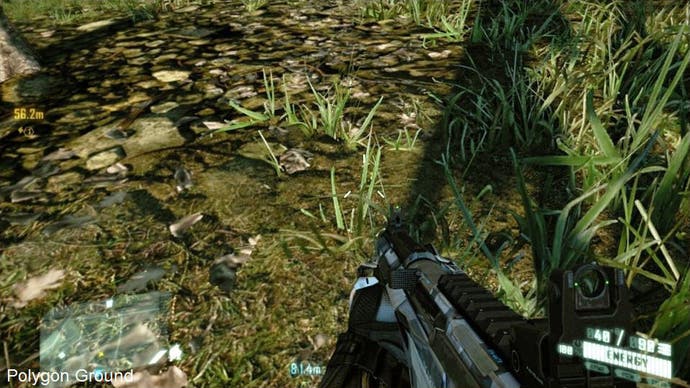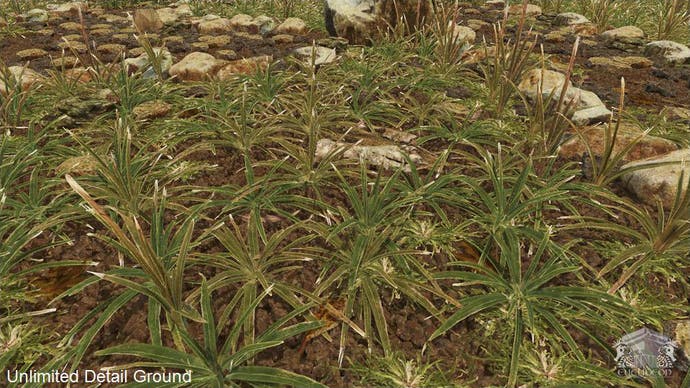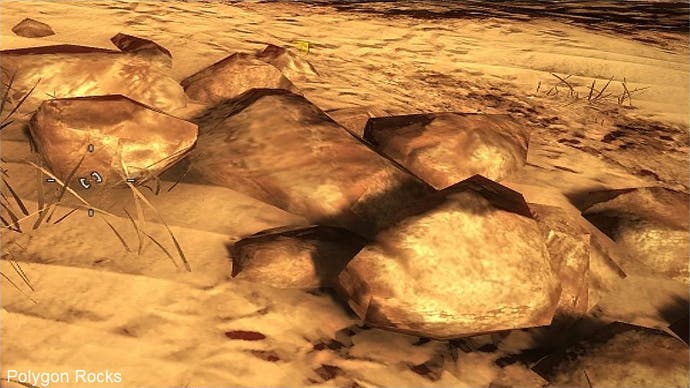Digital Foundry vs. Unlimited Detail
The devil's in the detail.
Beyond that, getting much in the way of information about how Unlimited Detail actually works proves fruitless, with Dell often choosing to be humorously defensive in answering even basic technological questions, or simply evading them altogether. When asked how the tech differs from approaches like Sparse Voxel Octree and Gigavoxel, Dell simply points out that the run-time speeds of these techniques are much slower than his, but doesn't offer more detail. Asked to clarify how much memory an atom uses, he suggests that an accurate answer would simply be unbelievable to us, and rather than try to win us over and evangelise his tech, he pursues a "wait and see" line of argument.
"If we were making our world out of little tiny atoms and had to store x, y, z, colour etc for each atom, then yes it would certainly use up a lot of memory," he acknowledges.
"But instead we've found another way of doing it. I could say we use less memory than what the current polygon system uses, but if I did that I think I'd exceeded my quote of unbelievable claims for the day. So we'll leave that for future demonstrations."
We also probed on how compatible Unlimited Detail is with the traditional vertices/skeletal animation/surface texturing approach used in current video game production. Bruce Dell readily admits that the lack of animation in his demos is the biggest point of criticism.
"Yes we can do animation, but it's not finished yet," he says.
"Last time, we learnt that if we were to put anything on the internet that wasn't finished, there would be hordes of forum people who are more grumpy than that donkey from Winnie the Pooh who would point the finger and say 'look at that, that doesn't look as good as polygons' no matter how hard we tried to say 'but we're only half done'. I'm sure our supporters understand the wisdom of us being silent on the topic of animation until it's completed."
Another criticism levelled at the demo is that the same objects are repeated across the island, the inference being that replication is being used to disguise basic limitations of the technology. Dell attempts to put the new video into context, saying that the decision to go ahead with a new demo only came a few weeks ago.
"Our aim was to show the technology, not necessarily beautiful graphics, I think we succeeded in our task, it's not a limitation of the technology, it simply came down to not having enough time to make more objects," he explains.
"We only have one artist and the poor guy has been slaving away to the point that even Cinderella would have pity on him - please don't accuse him of too much laziness. As said before, we're a technology company not a games company - that is all the art that could be included in the demo in such a short amount of time."


Fair enough perhaps, but what is curious about the demo is that the orientation of the objects is identical: they all face the same way. A very basic form of variety that could have transformed the look of the demo radically would have been to rotate the foliage objects by varying degrees.
The very simplistic lighting and materials also stand out, but again, Bruce Dell suggests that this is an early demo and we should not be judging it so harshly in its current state.
"When it comes to lighting, as we said in the video, it's not quite finished yet. Unlimited detail is a geometry system, like polygons are a geometry system. Lighting is something separate," he tells us.
"We have working examples where Unlimited Detail is using the lighting from the graphics card, they are entirely compatible. However, we're also working on a few lighting techniques of our own which you will see in the future."


To his credit, Dell does acknowledge the importance of current production workflows involving industry standard tools such as 3DS Max and Maya. They're all polygon-based, so Euclideon has developed a tool that converts these polygon-based constructions into point cloud data that can slip into the Unlimited Detail engine.
"Regarding polygon conversion, originally we were seen as the enemy of polygons: we constructed shapes out of little atoms, they were constructing shapes out of flat panels," Dell says.
"The games developers we were in contact with didn't want their development pipeline to be adjusted radically. This makes sense when you consider all the current artists, their skills and technique, and the fact that the current tools in 3DS Max, Maya and others are very, very good.
"So instead, we decided the best way forward would be to build a polygon converter. In effect what you have is a system that is converting polygons to little atoms, and then running those little atoms with our Unlimited Detail technology. But to the artist, they feel like they're just using unlimited polygons, their pipeline hasn't been changed in any huge way."
But again, how does it work? What we actually asked him was whether they are simply storing an atom for each point in the texture along each polygon surface, or if there is a more sophisticated technique at work: a pretty fundamental question any developer using these tools would ask - but even a basic question like this gets no straight reply.
"Well, I don't want to speak too much on our technique at this point in time," was the answer we got to the specific point we actually asked.
